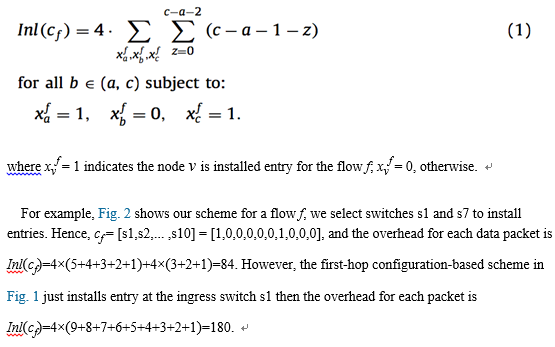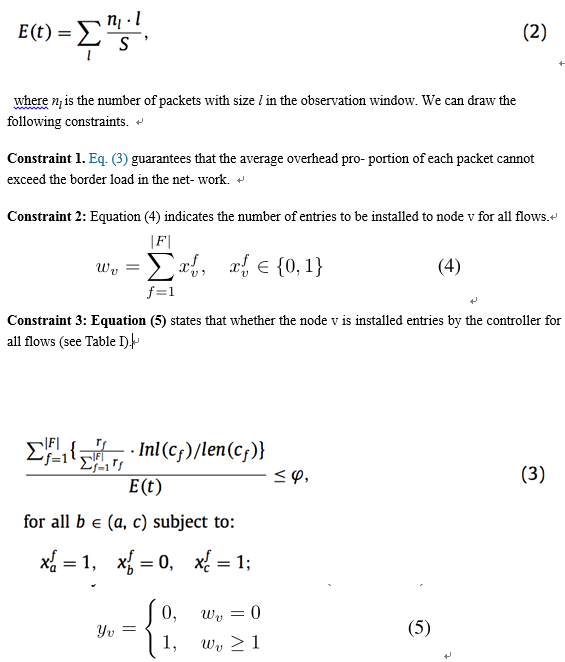A low overhead flow-holding algorithm in software-defined networks【2】
2.2. Holding more flows
If the network wants to hold more flows, the effective way is to aggregate the flow sets to improve the utilization of the flow table entries. We introduce the flow sets to path aggregation and path ID assignment methods based on the coincidence degree of flows
on the forwarding path [6]. KSGT achieves flow-level explicit path control by encapsulating MPLS labels to packets, which can com- press a large number of flows to a small number of routing entries in some switches on the forwarding path. Furthermore, KSGT can pre-install the flow entries through the controller’s pre-calculated according to the path ID.
2.2.1. Flow sets to path aggregation
Some works [12,14] propose the segment routing architecture and they detail the operation mechanism of segment routing in data centers and wide area networks. All these papers do not con- sider how to realize flow sets to path aggregation, and how to un- date the flow ID when new flows arrived. We propose a generic flows aggregation method based on segment routing. Moreover, [6] shows that DCNs do not intend to use all possible paths but a set of desired paths. While there also exist key nodes in the WAN that most of the traffic pass through them [20,21]. Thus, we improve the KSGT to select the least intermediate nodes to achieve maximum flow aggregation by encapsulating MPLS labels.
As Fig. 3(a) shows, we select some key nodes M in the network, while the flows come from source node S to destination nodes D must pass through at least one of them. The controller distributes the IDs to the flows form S to M and form M to D. According to the path ID the SDN switch encapsulates MPLS labels to the flows to indicate the switch ports of forwarding path.
2.2.2. Holding more flows
KSGT can reduce a large number of flow table entries by reusing the flow entries to encapsulate and decapsulate the MPLS labels. Our model in Section 3 uses a cost function to balance the flow table entries of different switches. Hence, KSGT can accommodate more flows even if the capacity of TCAMs in switches is limited.
The general packetout message of SDN is to install flow en- tries in all switches of forwarding path. But we just select a few switches to install flow entries by encapsulating the MPLS labels. It can save TCAM resources by reducing a large number of flow table entries. Moreover, unlike traditional MPLS technology, there is no need to maintain path state in forwarding path except on the ingress node, because packets are now routed based on the list of labels they carry [11]. The flow table compression based on path ID reduces the flow table entries. We reused the flow entries by encapsulating the MPLS labels for the flows of those forwarding paths are overlap. Moreover, we also reused the flow entries to pop up the MPLS labels as the switch port number of the forwarding path for the flows. In Fig. 3(b), if the flows come from source switches S through intermediate switch M1 to the destination D1, we can only install one flow entry in the switch M1 for all flows to encapsulate MPLS labels. Meanwhile, we only need to install one flow entry for each switch from M1 to D1 to pop MPLS labels as the forwarding port.
3 Problem Formulation
We formulate the reactive flow entry placement problem with the objective of achieving low overhead and more flows hold by properly selecting the placement and the number of contact switches. Let G = (V, E) be a network, where V is the set of nodes, and E is the set of links. Let $F$ denote the set of traffic flows. We use v to represent a node in the network, f to represent a flow in the network. Let r_f denote the arrival rate of flow f, and u_{max} be the flow table capacity of a SDN switch. We use u_v to denote the number of entries in the node v that have been installed before the arrival of the flows, w_v to denote the number of entries to be installed in the node v by controller for all flows. The full list of notations is shown in Table \ref{table:1}..
3.1 Constraints
in the network. Let r denote the arrival rate of flow f, and umax be the flow table capacity of a SDN switch. We use uv to denote the number of entries in the node v which have been installed before the arrival of the new flows, and wv to denote the number of entries to be installed in the node v by the controller for all flows. The full list of notations is shown in Table 1.
Definition 1 (Overhead). The MPLS labels cannot be regarded as payload. We define the overhead as Inl(cf) since the flow f is encapsulated with MPLS labels to carry the routing information [22,23]. The size of each MPLS label is 4 bytes, so the overhead for flow f can be formulated as:
Definition 2 (Border load). We define border load φ as the tolerable overhead proportion of each packet in the network.
The smallest data packet size is 46 bytes in the network, but the size of each MPLS label is 4 bytes [23]. In Fig. 1, if it just installs entry at the flow’s ingress switch, the size of MPLS labels is 4 × 9 = 36 bytes for each packet, and the overhead on the link between s1 and s2 is more than 12% of total load for these packets whose sizes are less than 300 bytes. Note that there are many different network packets whose sizes are between 100 bytes and 300 bytes according to the statistics in [17]. The longer the forwarding path is or the smaller the packet size is, the larger the overhead becomes [18]. So we must select some other nodes to install en- tries to reduce the overhead instead of just installing entries in the ingress switch. Hence, we define the border load ratio φ for each packet in the network to limit the overhead [24].
According to the measurement method in [25], we can suppose an observation window contains S packets at time t. The average packet size at time t is defined as
 |  |
分享让更多人看到 
推荐阅读
相关新闻
- 评论
- 关注































 第一时间为您推送权威资讯
第一时间为您推送权威资讯
 报道全球 传播中国
报道全球 传播中国
 关注人民网,传播正能量
关注人民网,传播正能量